| Skip Navigation Links | |
| Exit Print View | |

|
Sun Server X3-2L HTML Documentation Collection |
Getting the Latest Software and Firmware
Preparing the Site for Installation
About the Installation Procedure
Installation Procedure Overview
About Server Features and Components
Front Panel Status Indicators, Connectors, and Drives
Back Panel Status Indicators, Connectors, Drives, and PCIe Slots
Server Management Software Overview
Preparing for Server Installation
Optional Component Installation
Tools and Equipment Needed for Installation
Installing the Server Into a Rack
Safety Precautions When Rackmounting the Server
Stabilize the Rack for Installation
Attach Tool-less Slide-Rail Assemblies
Install the Server Into the Slide-Rail Assemblies
Install the Second-Generation Cable Management Arm
Remove the Second-Generation Cable Management Arm
Install the First-Generation Cable Management Arm
Rear Cable Connections and Ports
Attaching Data Cables and Power Cords to the Server
Oracle ILOM Hardware and Interfaces
Logging In to Oracle ILOM Using a Local Serial Connection
Logging In to Oracle ILOM Using a Remote Ethernet Connection
Accessing the Host Console Through Oracle ILOM
Troubleshooting the Service Processor Connection
Setting Up Software and Firmware Using Oracle System Assistant
Setting Up an Operating System and Drivers
Configuring Server Drives for OS Installation
RAID Configuration Requirements
Configuring Storage Drives Into RAID Volumes Using Oracle System Assistant
Configuring RAID Using the BIOS RAID Configuration Utilities
Configuring the Preinstalled Oracle Solaris 11 Operating System
Preinstalled Operating System RAID Limitations
Oracle Solaris Configuration Worksheet
Configure the Preinstalled Oracle Solaris 11 Operating System
Oracle Solaris 11 Operating System Documentation
Configuring the Preinstalled Oracle Linux 6.x Operating System
Oracle Linux 6.x Configuration Worksheet
Configure the Preinstalled Oracle Linux Operating System
Register and Update Your Linux OS
Oracle Linux Operating System Documentation
Configuring the Preinstalled Oracle VM 3.x Software
Preinstalled Oracle VM Server and Oracle VM Manager Compatibility Requirements
Oracle VM Server Configuration Worksheet
Configure the Preinstalled Oracle VM
Controlling System Power and Troubleshooting Installation Issues
Power Off the Server for Orderly Shutdown
Power Off the Server for Immediate Shutdown
Technical Support Information Worksheet
Locating the System Serial Number
Getting Server Firmware and Software
Firmware and Software Access Options
Getting Firmware and Software from MOS or PMR
Installing Updates Using Other Methods
About Oracle Solaris Operating System Installs
Oracle Solaris OS Installation Task Map
Selecting the Console Display Option
Selecting the Boot Media Option
Selecting the Installation Target Option
Solaris OS Installation Options
Preparing to Install the Operating System
Installing the Oracle Solaris Operating System
Installing the Oracle Solaris 10 or 11 Operating System on a Single System Using Media
Post Installation Tasks for Oracle Solaris
Getting Server Firmware and Software
Firmware and Software Access Options
Getting Firmware and Software From MOS or PMR
Installing Updates Using Other Methods
Oracle VM Installation Task Map
Selecting the Console Display Option
Selecting the Boot Media Option
Selecting the Installation Target Option
Oracle VM Installation Options
Single-Server Installation Methods
Preparing to Install Oracle VM
Verify the BIOS Factory Defaults
Installing Oracle VM on a Single System Using Oracle System Assistant
Installing Oracle VM on a Single System Using Media
Post Installation Tasks for Oracle VM
Configuring Network Interfaces
Getting Server Firmware and Software
Firmware and Software Access Options
Getting Firmware and Software From MOS or PMR
Installing Updates Using Other Methods
About Linux Operating System Installs
Supported Linux Operating Systems
Oracle Unbreakable Enterprise Kernel for Linux
Selecting the Console Display Option
Selecting the Boot Media Option
Selecting the Installation Target Option
Oracle System Assistant Overview
Get Updates and Install OS Tasks
Obtaining Oracle System Assistant
Preparing to Install the Operating System
Configuring the SLES 11 SP1 Operating System Software to Support Network Connections
Installing the Linux Operating System
Installing a Linux OS on a Single System Using Oracle System Assistant
Installing Oracle Linux on a Single System Using Media
Installing Red Hat Enterprise Linux on a Single System Using Media
Installing SUSE Linux Enterprise Server on a Single System Using Media
Configuring Network Interfaces
Getting Server Firmware and Software
Firmware and Software Access Options
Getting Firmware and Software From MOS or PMR
Installing Updates Using Other Methods
About Microsoft Windows Server Operating System Installs
Windows OS Installation Task Map
Supported Windows Operating Systems
SAS PCIe HBAs Requiring LSI Mass Storage Driver for Windows Server 2008 SP2
Selecting the Console Display Option
Selecting the Boot Media Option
Selecting the Installation Target Option
Windows OS Installation Options
Preparing to Install the Operating System
Installing Windows Server Operating System
Installing Windows Server on a Single System Using Oracle System Assistant
Install Windows Server Using Oracle System Assistant
Installing Windows Server on a Single System Using Media
Install Windows Server 2008 (SP2 or R2 SP1) Using Local or Remote Media
Install Windows Server 2008 (SP2 or R2 SP1) or Windows Server 2012 (R2) Using PXE Network Boot
Post Installation Tasks for Windows Server
Supplemental Software Component Options
Installing Device Drivers and Supplemental Software
Getting Server Firmware and Software
Firmware and Software Access Options
Getting Firmware and Software from MOS or PMR
Installing Updates Using Other Methods
VMware ESXi Installation Task Map
Supported VMware ESXi Software
Selecting the Console Display Option
Selecting the Boot Media Option
Selecting the Installation Target Option
VMware ESXi Installation Options
Preparing to Install VMware ESXi
Configuring the VMware ESXi 5.0 Software or the Server Hardware to Support Network Connections
Installing VMware ESXi on a Single System Using Media
Post Installation Tasks for VMware ESXi
Configure Network Adapter Settings
Determine the MAC Address of a Connected Server Network Port
Update the VMware ESXi Software
Configuring Network Interfaces
Getting Server Firmware and Software
Firmware and Software Access Options
Getting Firmware and Software from MOS or PMR
Installing Updates Using Other Methods
About Server and Component LEDs
Service Troubleshooting Task List
Locate the Server Serial Number
Electrostatic Discharge Safety
Preparing the Server for Component Replacement
Servicing CRUs That Do Not Require Server Power-Off
Servicing Storage Drives and Rear Drives (CRU)
Servicing Power Supplies (CRU)
Servicing CRUs That Require Server Power-Off
Servicing the SAS Expander Module (CRU)
Servicing the Air Baffle (CRU)
Servicing the Internal USB Flash Drives (CRU)
Servicing the Front and Rear Storage Drive Backplanes (FRU)
Servicing the Front LED/USB Indicator Modules (FRU)
Servicing the Motherboard Assembly (FRU)
Returning the Server to Operation
Server Filler Panel Requirements
Remove and Install Filler Panels
Reinstall the Server Chassis in the Rack
Reconnect Power and Data Cables
Getting Server Firmware and Software
Firmware and Software Access Options
Getting Firmware and Software From MOS or PMR
Installing Updates Using Other Methods
Planning the System Management Environment
Choosing Tools for Single System Management
Choosing Tools for Multiple System Management
System Management Tools Overview
Common System Management Tasks
Common System Administrative Tasks
Evaluating the Server Environment
Installing System Management Tools
System Management Documentation
Accessing System Management Tools
Accessing Oracle System Assistant
Accessing Oracle Hardware Management Pack
Setting Up Software and Firmware
Set Up Software and Firmware Using Oracle System Assistant
Set Up Software and Firmware Using Oracle ILOM
Set Up Software and Firmware Using Oracle Hardware Management Pack
Setting Up the Server Using Oracle System Assistant
Organization of Oracle System Assistant
Configuring the Server Using Oracle System Assistant
Mounting the Oracle System Assistant USB Flash Drive
Troubleshooting Oracle System Assistant
Accessing the Oracle System Assistant Filesystem
Managing the Server Using Oracle ILOM
Oracle ILOM Features for Oracle x86 Servers
Supported HBA Disk Controllers
Creating a RAID Volume Before Installing an Operating System
Creating a RAID Volume After Installing an Operating System
Using Oracle ILOM to Monitor Storage Devices
Setting Up BIOS Configuration Parameters
Managing the BIOS Configuration
Accessing the BIOS Setup Utility
Using BIOS for Resource Allocation
Common BIOS Setup Utility Tasks
BIOS Setup Utility Menu Options
UEFI Driver Control Menu Selections
BIOS Save & Exit Menu Selections
Monitoring Components and Identifying SNMP Messages
Monitoring Component Health and Faults Using Oracle ILOM
Identifying SNMP Trap Messages
Getting Server Firmware and Software
Firmware and Software Access Options
Getting Firmware and Software from MOS or PMR
This procedure describes how to boot the Microsoft Windows Server 2012 operating system from local or remote media. It assumes that you are booting the Windows installation media from one of the following sources:
Windows Server 2012 CD or DVD
Windows Server 2012 ISO image
Note - The Windows Server 2012 ISO image can be used for remote installation or for creating an installation CD or DVD.
Note - If you are booting the installation media from a PXE environment, refer to Install Windows Server 2008 (SP2 or R2 SP1) or Windows Server 2012 (R2) Using PXE Network Boot for instructions.
For additional information about how to set up the installation media, see Selecting the Boot Media Option.
For example:
The BIOS screen appears.

Note - The next events occur very quickly; therefore, focused attention is needed for the following steps. Watch carefully for these messages as they appear on the screen for a brief time. You might want to enlarge the size of your screen to eliminate scroll bars.
The Please Select Boot Device menu appears. The screen that appears will be different depending on whether you have BIOS configured for Legacy mode or UEFI mode.
For Legacy BIOS, a screen similar to the following appears:
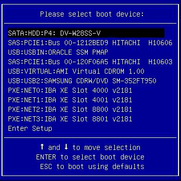
For UEFI BIOS, a screen similar to the following appears:
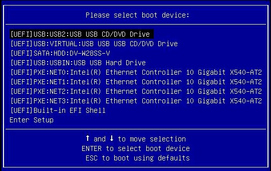
Note - The boot device menu that appears in your installation might differ depending on the type of disk controller installed in your server.
For example:
The Windows installation wizard starts and the Loading files... screen appears.
The Windows installation wizard continues until the Language Localization dialog appears.
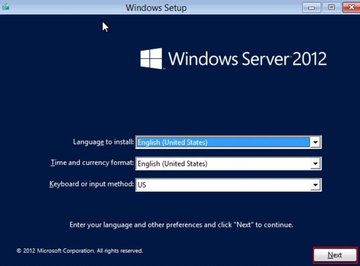
The Install Now screen appears.
Note - The Install Now screen allows you to continue the installation or access an optional Repair menu (see lower left of the screen) for troubleshooting.
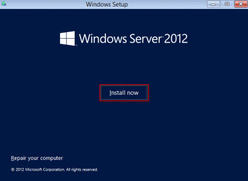
The Setup Is Starting screen appears.
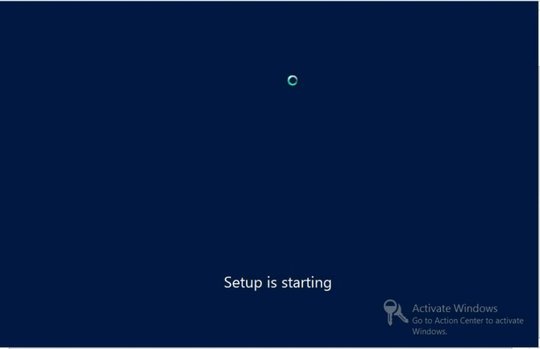
Then the Select Operating System dialog appears.

For most installs, select Windows Server 2012 Datacenter (Server with GUI) at the bottom of the list.
For more information on the different types of Windows operating systems, see the Windows 2012 documentation at http://technet.microsoft.com/en-us/windowsserver/default.aspx.
The License Terms screen appears.

The Which Type of Installation Do You Want dialog appears.

The Where Do You Want to Install Windows dialog appears.
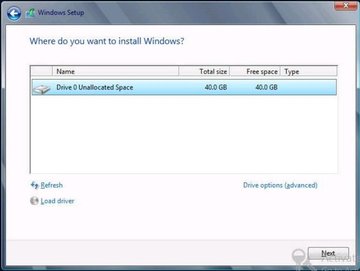
The Installing Windows screen appears.
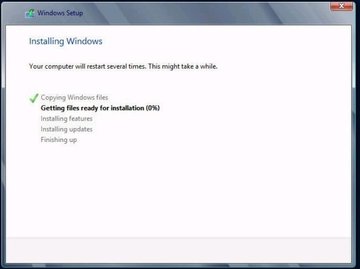
The setup and installation process begins and files are copied to the target.
The Windows Needs to Restart to Continue screen appears.

The system reboots.
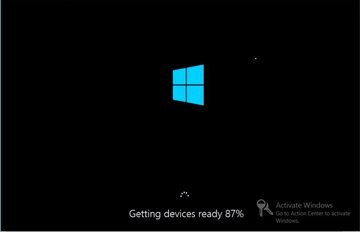
After the devices are configured, the system reboots again and the Settings screen appears.
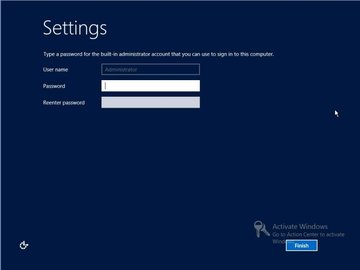
The Finalizing Your Settings screen appears.
This screen indicates that the Windows operating system has been installed.

The Administrator log in screen appears.

The Windows Server 2012 desktop appears.
This completes the installation.